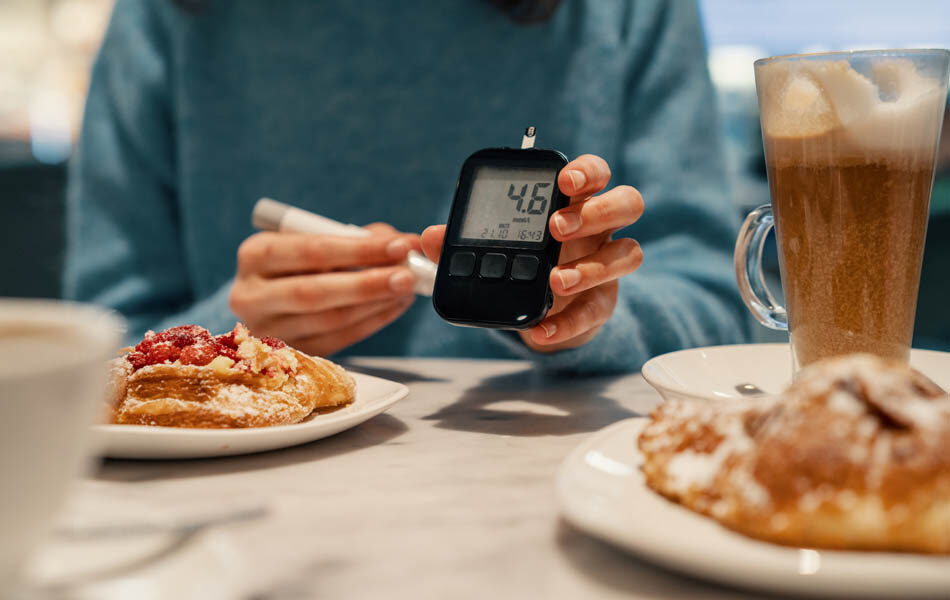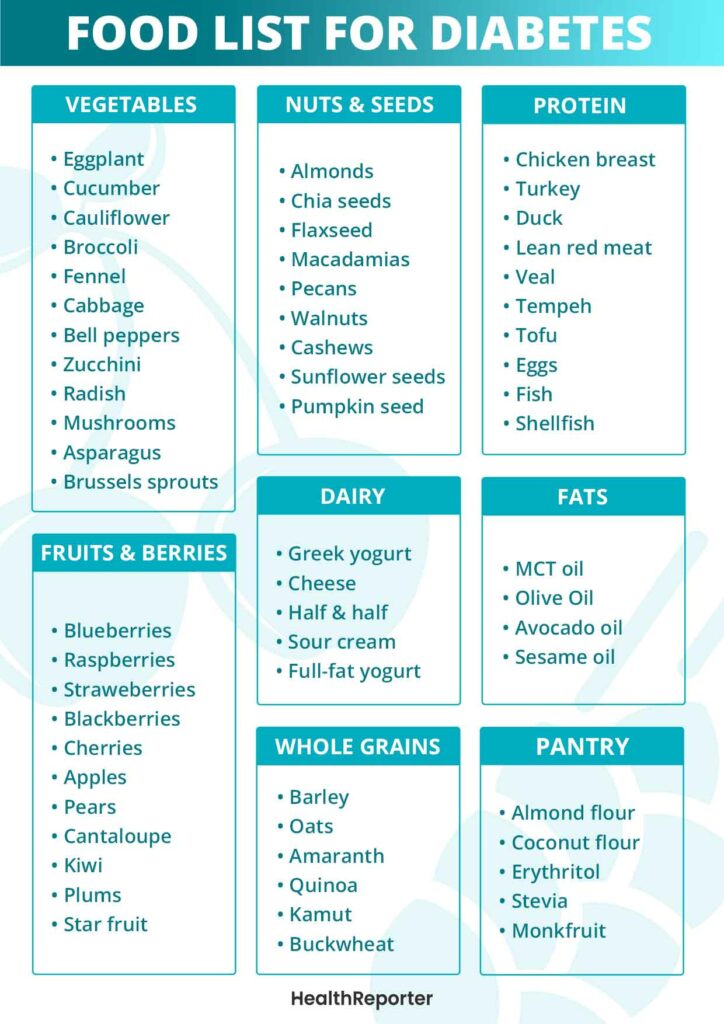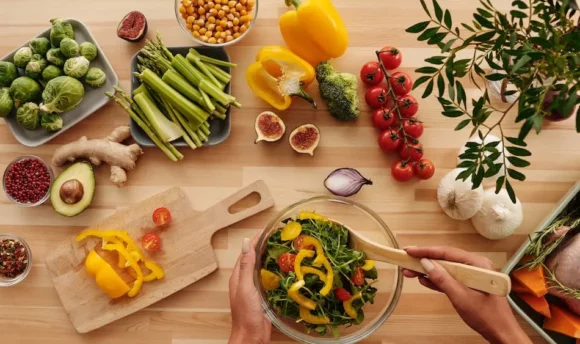Type 2 Diabetes Food List: 15 Foods Suitable for Your Diet
Finding the right food for diabetes can be challenging. You might not know which food groups are safe, but don’t worry – we have a list! Keep reading to find 15 delicious food ideas, including their health benefits for people with type 2 diabetes.

People living with diabetes need to be careful of what kinds of foods they eat.
Following the right diet ensures your blood glucose levels are within a healthy range. However, it can be confusing if you have just been diagnosed with the condition, and finding the right foods might take some time.
In this article, you’ll find 15 delicious foods people with diabetes can safely eat so you can make the right choices for your condition. Have a look to find out more about their benefits.
An Extended Type 2 Diabetes Food List
For people with diabetes, it is important to follow a diet that will not push their blood sugar levels above what is healthy. This means following a diabetes diet that contains fewer saturated fats and refined carbs.
We’ve summarized various healthy foods people with type 2 diabetes can eat as part of a balanced eating plan below. Take a look to find more foods to add to your diet.
#1 Berries
Berries are often recommended for people with type 2 diabetes. They’re known for their high antioxidant content and an incredible amount of dietary fiber. Good choices include blueberries, raspberries, strawberries, blackberries, and cherries.
Blueberries are thought to be particularly good for diabetes. Indeed, one study showed that blueberries, among other berries, could help reduce the risk of developing type 2 diabetes and help those with the condition better manage it.
Berries are generally good sources of fiber, an essential macronutrient for blood sugar regulation and type 2 diabetes management. Getting more fiber into your diet will help to reduce fasting blood sugar and ensure your blood sugar doesn’t spike to unhealthy levels.
#2 Fruits
It is a common myth that you cannot eat fruit as part of a diabetes meal plan. In fact, there are several low-carb fruits that are suitable for people with diabetes and can help keep blood sugar levels within a healthy range.
Apples, pears, peaches, cantaloupe, kiwi, plums, and star fruit are all substantial sources of fiber and vitamins, minerals, and other plant compounds that keep you in good overall health. It is important that you avoid fruit juice, though. While whole fruits have lots of fiber to help regulate blood glucose levels, fruit juice does not and will cause a bigger blood sugar spike.
#3 Vegetables
There are many vegetables that people with diabetes can safely consume, and excellent choices include eggplant, cucumber, cauliflower, broccoli, fennel, cabbage, bell peppers, zucchini, radish, mushrooms, avocado, and asparagus.
Vegetables are high in fiber, and if you opt for low-carb veggies, you’ll get a dose of vitamins, minerals, fiber, and plant compounds without a huge spike in blood sugar. Pay attention to how you prepare vegetables, and if roasting, remember to use heart-healthy oils, like olive oil, rather than butter and lard.
Vegetable juices, unlike fruit juices, tend to have lower sugar content; however, care should still be taken to not consume too much of vegetable juice and instead opt for whole vegetables. Carrot juice could be a good option to get your nutrients, but it should always be consumed in moderation.
#4 Nuts and seeds
Nuts and seeds are incredibly energy dense. They are packed full of vitamins and minerals and contain healthy, unsaturated fats and omega-3 fatty acids. They’re also usually relatively low in carbohydrates.
Some nuts and seeds contain high magnesium levels, including almonds and cashews. Magnesium is good for people with diabetes as it is used by the body to manage insulin secretion and could be used to help the body respond better to insulin too.
Seeds like chia seeds and flaxseeds are also very high in fiber. As previously discussed, fiber is an important nutrient in regulating blood glucose levels and is part of a healthy diet for people with diabetes.
Good nut and seed options for people with diabetes include sunflower seeds, walnuts, macadamia nuts, pecans, cashews, almonds, chia seeds, and flaxseeds.
#5 Meat
Though processed meats should be totally avoided on a diabetes-friendly diet due to their high fat content, lean meat like skinless turkey breast, skinless chicken breast, veal, duck, and very lean red meat options are acceptable. Meat is low in carbs and high in lean proteins.
#6 Protein-rich products
For people on a vegetarian or vegan diet, getting protein means finding plant-based and non-meat versions of protein. Excellent sources of non-meat-based protein for people with diabetes include tofu, tempeh, and eggs.
Tofu may also be an effective tool for reducing the risk of developing type 2 diabetes in the first place, though more research is needed to fully confirm its benefits.
#7 Healthy fats
With a diagnosis of type 2 diabetes, you’ve probably been told to avoid foods that are high in unhealthy fats, but you can still consume unsaturated fats. Excellent sources of healthy and unsaturated fats include olive oil, avocado oil, and sesame oil. You could also try MCT oil to help reduce insulin resistance.
Contrary to what used to be believed, fat is an essential part of a healthy and balanced diet. Indeed, fat helps certain vitamins to be absorbed, and unsaturated fats come with other benefits, including reducing your risk of heart disease and decreasing your cholesterol levels.
#8 Legumes
Legumes are a fantastic source of fiber and are sometimes called diabetes “superfood.” There is research that has shown legumes can be extremely beneficial for people with type 2 diabetes in helping them regulate their blood glucose levels and manage their condition effectively.
There are tons of legume options for people with diabetes, including various beans, chickpeas, lentils (lentil soup is also a great option), and green peas. They can be added to stews, curries, and even soups for added fiber and protein.
#9 Leafy greens
We already know that vegetables are healthy foods that we should eat more of, but there is new research that shows a link between increased vegetable intake and better glycemic control. And it shows that leafy greens, in particular, can support better blood sugar management.
Leafy greens include kale, spinach, broccoli, arugula, swiss chard, and bok choy. They can be used in a variety of ways, including as a low-calorie way to balance a meal, in smoothies, and in sauces. While starchy vegetables are a little more precarious for those with diabetes, leafy greens are an easy way to boost your nutrient intake without affecting your condition.
#10 Whole grains
Whole grains are complex carbohydrates, which means they have a lower glycemic index than refined grains, like those found in white bread. This means that while you’re decreasing your intake of refined foods, you need to increase your intake of whole-grain-based foods.
Good grains to include in your diet include barley, oats, amaranth, quinoa, Kamut, and buckwheat. They can help you maintain a healthy blood glucose level, but remember that they are still carbs.
When consuming carb-based products with diabetes, we recommend sticking to your healthcare provider’s guidance and noting down your intake, as any carb will raise blood sugar levels.
#11 Dairy products
Dairy (or a non-dairy alternative) is essential to your health. Dairy products contain lots of nutrients that your body needs; however, many dairy products contain high amounts of fat. For this reason, we recommend switching to low-fat or non-fat dairy products, for the most part, to keep your fat intake to a minimum.
Good dairy product choices include Greek yogurt, cheese, half-and-half, sour cream, cream, and full-fat yogurt. The key with dairy is sticking to recommended portion sizes and watching your fat and salt intake.
#12 Seafood
Seafood is recommended as part of a healthy and balanced diet at least twice weekly. It is a source of high-quality protein and is rich in omega-3 fatty acids, which are great for heart health.
For people with diabetes, it is best to grill, broil, or bake fish to keep extra carbs and fat to a minimum. Seafood includes fatty fish like salmon and sardines, as well as shellfish like oysters and crab.
As with any food we recommend, speak with a doctor for exact portion sizes and make sure to stick to them to avoid affecting your condition negatively!
#13 Sweeteners
Though it is recommended that you avoid adding sugar to your hot beverages, you can add sweeteners like stevia, monk fruit, and erythritol. These sweeteners, though much sweeter than sugar in most cases, have zero carbs, zero calories, and zero effect on your blood sugar.
There has been lots of research into the effect of sweeteners on diabetes, and stevia has been found to have no impact on blood sugar or people with diabetes lipid profiles.
#14 Pantry items
With diabetes, you need to keep your carb intake to a minimum, which is why regular pantry items, like white flour, aren’t the best choice. There are, however, some great alternatives. We’ve already discussed sweeteners, like stevia and monk fruit, which can be used in baking, and flour options include almond flour and coconut flour.
Almond flour is essentially almonds ground up very finely. This means it is packed full of protein, fiber, and heart-healthy fat. It has a low glycemic index, making it the perfect option for people with diabetes.
Coconut flour is made from the dried meat of coconut fruit. It has more fiber, which helps with blood sugar regulation, and is lower in carbs. It, too, has a low glycemic index.
It is worth noting that these flour alternatives behave differently from wheat flour when baking, so doing some research to work out the best proportions for substitution is a good idea!
#15 Beverages
While water is always the best option for hydration, you may want something flavored every once in a while. It is recommended that you avoid sweetened, high-sugar beverages like soda and other fizzy drinks. You should also opt to eat whole fruit rather than fruit juice.
However, some vegetable juice, like celery juice, is relatively low in sugar and can be consumed in moderation by those with diabetes. In addition, unsweetened tea and coffee are good choices, as is sparkling water.
What Foods Can People With Diabetes Eat Freely?
The American Diabetes Association says that there is no specific diet that works for all people with diabetes, but healthy food from each food group should be consumed in alignment with the eating plan your healthcare team has recommended. This means you can eat quite a lot of food when you have diabetes.
Fruit, vegetables, whole grains, lean and high-quality protein, and non-fat or low-fat dairy can all be consumed when you have type 2 diabetes. You should also consume heart-healthy fats, like extra virgin olive oil, and avoid saturated fat and highly processed foods.
If you’re struggling to properly understand what is considered a healthy diet, you could try downloading a diabetes management app like Klinio. The app allows people with type 2 diabetes to track their caloric and macronutrient intake to better manage their condition.
It also contains 45,000+ recipes that are all suitable for diabetes. This can help you build an eating plan for managing your blood sugar levels. Each recipe comes with easy swaps and takes between 15 and 20 minutes to make.
Also, for those with other conditions alongside type 2 diabetes, like heart disease, the app helps to build the perfect meal plan for your condition.
On top of the progress tracking features and meal plans, the Klinio app offers no-equipment workouts so that you can boost your physical activity. These workouts can easily be completed at home, so you don’t have to worry about traveling to your nearest gym.
Printable List of Foods for Diabetes
To make things as easy as possible, we’ve created a printable list of healthy foods you can eat as part of a type 2 diabetes-friendly diet. It includes all the foods we have summarized above, so you always have them on hand.

A Word From Our MD
Contrary to popular belief, a diagnosis of type 2 diabetes doesn’t immediately restrict your diet. In fact, you can usually eat from most food groups provided you stick to your individual meal plan set out by a doctor.
People with type 2 diabetes are recommended to reduce their intake of saturated fats, processed foods, sweetened and sugary beverages, sweets, candy, baked goods, and simple carbohydrates. But this means they can still eat fruits, vegetables, whole grains and other complex carbohydrates, lean protein, and low-fat dairy products.
The key is to choose healthier foods. For example, always choose brown rice over white rice, and opt for whole fruits rather than fruit juice to ensure you get the fiber along with the sugar content. You should also cut down on your alcohol consumption and switch to healthier fats.
There is no one diet that works for everyone, so we recommend following the meal plan set out for you by your healthcare provider and ensuring you eat healthy and whole foods for proper nourishment.
Conclusion
While there isn’t a so-called diabetes diet that fits everyone, there are some general rules that most people should follow, including finding foods that are low in refined carbs, saturated, unhealthy fats, and added sugars. Making these healthy eating choices ensures your blood sugar is kept within a healthy range and helps promote better heart health.
Always follow the guidelines that your healthcare provider gives you, and if in doubt about what you can eat, speak with your doctor! Your health matters, and finding what works for you is essential for good diabetes health.

















































 Select your language:
Select your language: 








